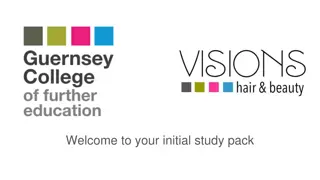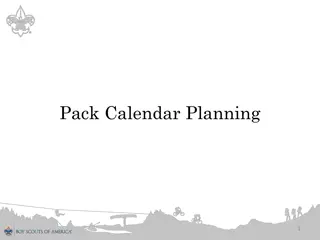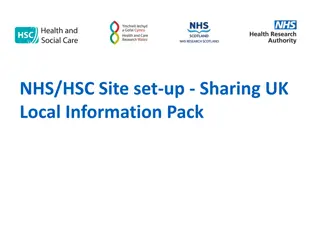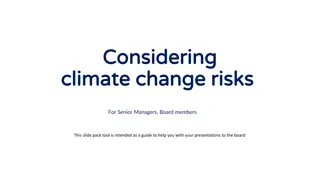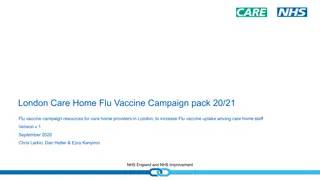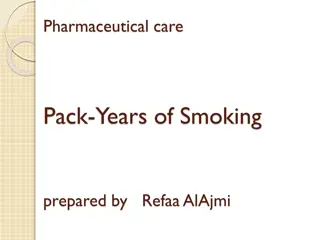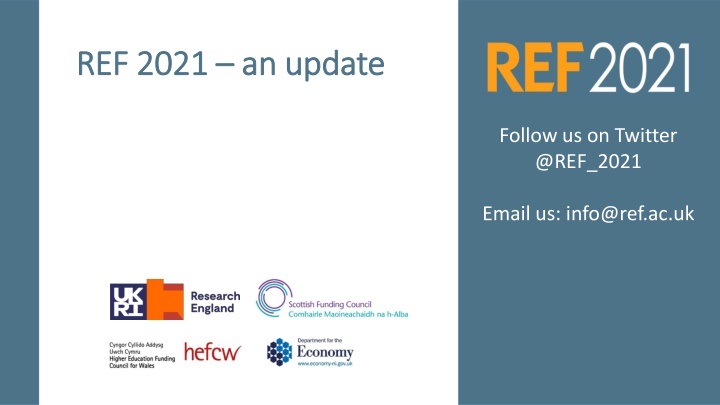
REF 2021 Updates and Key Changes in Research Excellence Framework
Stay informed about the latest updates and key changes in the Research Excellence Framework (REF) 2021. Discover insights on guidance, criteria, panel criteria, staff submissions, eligibility, and more important aspects affecting research assessment. Follow REF_2021 on Twitter and contact info@ref.ac.uk for further information.
Download Presentation

Please find below an Image/Link to download the presentation.
The content on the website is provided AS IS for your information and personal use only. It may not be sold, licensed, or shared on other websites without obtaining consent from the author. If you encounter any issues during the download, it is possible that the publisher has removed the file from their server.
You are allowed to download the files provided on this website for personal or commercial use, subject to the condition that they are used lawfully. All files are the property of their respective owners.
The content on the website is provided AS IS for your information and personal use only. It may not be sold, licensed, or shared on other websites without obtaining consent from the author.
E N D
Presentation Transcript
REF 2021 REF 2021 an update an update Follow us on Twitter @REF_2021 Email us: info@ref.ac.uk
2018 consultation on guidance and criteria 294 respondents Views sought on clarity broad agreement (70% +) across most areas Some areas showing well over 80% agreement Not always good indicator of feedback! Mixed views on key issues
Key changes Guidance on submissions Guidance on submissions Approach to taking account of staff circumstances Additional clarification on research independence and significant responsibility Eligibility of staff in non-UK based units Eligibility of outputs by former staff made redundant Version of output returned (former staff) Returning co-authored outputs more than once in same submission Tolerance band for open access Word limit for institutional level environment statement
Key changes Panel criteria Panel criteria Research independence Co-authorship statements Double weighting Continued impact case studies Increased focus on equality and diversity in environment
Staff submission All staff with significant responsibility for research should be returned to the REF Category A eligible Category A submitted - Teaching and Research or Research only Accurately identifies staff with significant responsibility for research 100 per cent returned - Independent researcher Staff with significant responsibility returned, following process developed, consulted on and documented - Minimum of 0.2 FTE Some T&R staff do not have significant responsibility for research - Substantive connection Approach may vary by UOA where employment practices vary at this level
More on eligibility Substantive connection Substantive connection Statement required for staff on 0.20-0.29 FTE evidence of participation in and contribution to the unit s research environment evidence of wider involvement in the institution evidence of research activity focused in the institution period of time with the institution Statement not required where particular personal and discipline-related circumstances apply
Staff in non-UK based units Staff employed by the UK HEI and based outside the UK will be eligible if the primary focus of their research activity on the census date is clearly and directly connected to focus of their research activity on the census date is clearly and directly connected to the submitting unit based in the UK the submitting unit based in the UK. HEIs should use guidance on demonstrating a substantive connection to help determine whether they are eligible Eligible staff should be returned to HESA. REF team is working with HESA to update their guidance. if the primary
Independent researchers An individual who undertakes self-directed research, rather than carrying out another individual s research programme Research assistants / associates not normally eligible GOS includes generic indicators, including: Being named as principal investigator Holding an independently won, competitively awarded fellowship where research independence is a requirement. (List at www.ref.ac.uk/guidance) Leading a research group or a substantial or specialised work package. leading a research group or a substantial or specialised work package. Main Panels C and D supplementary criteria independent researchers 1. C and D also consider that the following attributes may generally indicate research independence in their disciplines: In addition to the generic criteria specified in the Guidance on submissions , Main Panels Being named as a Co-I on an externally funded research grant/award. Having significant input into the design, conduct and interpretation of the research.
Significant responsibility Staff for whom: Staff for whom: Explicit time and resources are made available proportion of time allocated for research, as determined in the context of the institution s practices and applied in a consistent way research allocation in a workload model or equivalent. to engage actively in independent research eligibility to apply for research funding as the lead or co-applicant access to research leave or sabbaticals membership of research centres or institutes within the HEI. and that is an expectation of their job role. current research responsibilities as indicated in, for example, career pathways or stated objectives expectations of research by role as indicated in, for example, job descriptions and appraisals.
Staff circumstances Clear feedback from 2016 REF consultation that we need measures to take account of individual circumstances Decisions document (Nov 2017) set out two measures: Reducing no. of outputs required for units with high proportions of staff with individual circumstances Removing min. of one output requirement for those with exceptional circs During development, significant concerns that approach based on effects of circumstances on unit s overall output pool, rather than on individual contributions to it, not sufficient to ensure E&D fully supported
Key principles Ensure recognition of the effect circumstances can have upon an individual researcher s productivity. Create the right incentives for HEIs to support staff with circumstances (and avoid introducing negative incentives, for example around recruitment). Recognise the potential disparity in the available output pool for units in particular contexts, for example where there are high proportions of staff with circumstances. Maintain the integrity of exercise both in supporting equality and diversity and ensuring the credibility of assessment process. Focus on HEIs responsibility to support staff with circumstances Empower individuals to declare their circumstances
Staff circumstances reductions Up to 1.5 output reduction per staff member More simplified approach to submitting information requests at unit, not individual, level Reduction in unit s required no. of Reduction in unit s required no. of outputs outputs Removal of minimum of one output Removal of minimum of one output Optional reduction in output requirement where staff have not been able to research productively due to individual circumstances. Defined reductions for: Exceptional circumstances where the individual has not been able to produce an output Individual may be returned without min. of one output Early career researchers Unit s output requirement will be further reduced by one Secondments/career breaks Family-related leave Clinical lectureships Plus circumstances equivalent to absence that require a judgement
Codes of practice Code of practice to cover: Process(es) for identifying staff with significant responsibility for research (where not submitting 100%) Process for ensuring a fair approach to selecting outputs, incl. those of former staff Process(es) for determining who is an independent researcher Guidance on codes of practice, including template at www.ref.ac.uk. EDAP has examined the codes and advised the funding bodies. Publication intended early 2020. HEIs will need to provide final versions in early 2021.
Outputs decoupling Number of outputs per submission Output pool to include Max of 5 attributed to individuals FTE of Cat A submitted May include outputs of staff that have left Min of 1 per Cat A submitted Number of outputs Submitted outputs 2.5
Outputs non-portability Outputs may be submitted by: the institution employing the eligible staff member on the census date; and the institution employing the eligible staff member when the output was first made publicly available For former staff: Includes: for staff still employed, but no longer on eligible contract, outputs produced while employed as eligible; and outputs of staff on secondment / leave of absence Excludes: any outputs produced before / after period of eligible employment; outputs by staff still on Cat A contracts but who no longer have significant responsibility for research.
Outputs non-portability Redundancy Redundancy Funding bodies consulted on whether HEIs should be able to submit the outputs of former staff who have since been made redundant Very mixed responses opinion split almost 50/50 Concerns raised by those against the proposal: Would affect those on fixed-term contracts, incl. ECR research fellowships. Creates disincentive for HEIs to invest in these fellowships if unable to return outputs. Could have a negative effect on future career prospects of those made redundant if they couldn t point to outputs submitted to REF Would require HEIs to share sensitive confidential data on who has been made redundant with academic departments Require HEIs to set out approach to submitting outputs of former staff, incl. those made redundant, in the code of practice and the UOA environment statement
Outputs version Proposed in draft guidance that HEIs submitting outputs of former staff must submit the version that was made publicly available when they were employed by that institution Feedback from sector and consultation with panels revealed preference for submitting final version Concerns that it is not always possible to identify the final version (e.g. for practice outputs) HEIs can submit either version made available during employment or final version
Co-authored outputs Submitting more than once: Submitting more than once: Consulted on whether HEIs should be able to submit an output more than once in a submission to a UOA Mixed response from sector suggested disciplinary differences might be justified Main Panels A-C will not permit this Main Panel D will permit submission up to two times. Such outputs may make up max. 5% of submission. Cannot be combined with double-weighting Contribution information: Contribution information: Appetite expressed in consultation for alignment between MPs A and B Agreed to follow same process and reached compromise position of 15 authors (increase from 6 in MP A and decrease from 25 in MP B) Further reflection in MP B revealed that this was only necessary in SP 9 (Physics) other SPs will not require a contribution statement
Double-weighting outputs Alignment of criteria in Main Panels C and D Removal of reference to the disciplinary norm Expectation that most books will warrant double-weighting BUT this is not automatic Suggestion in consultation that HEIs should submit a ranked list of reserve outputs, rather than linking them to specific outputs Panels agreed that this was unnecessarily complicated
Outputs open access Outputs deposited as soon after the point of acceptance as possible, and no later than three no later than three months months after this date from 1 April 2018. Deposit exception from 1 April 2018 outputs remain compliant if they are deposited up to three months after the date of publication. Additional flexibility 5% tolerance band (or one output or one output) per submission to a UOA
Impact Consistency with REF 2014 Consistency with REF 2014 Impact remains non-portable 2* quality threshold Timeframe: 1 January 2000 - 31 December 2020 for underpinning research 1 August 2013 - 31 July 2020 for impacts Refinements Refinements Impact template integrated into Environment statement Impact on teaching within (and beyond) own HEI is eligible Enhanced clarity on scope of underpinning research bodies of work Guidance on submitting continued impact case studies Enhanced guidance on public engagement
Impact criteria Reach Significance the extent and/or diversity of the beneficiaries of the impact, as relevant to the nature of the impact. (It will not be assessed in geographic terms, nor in terms of absolute numbers of beneficiaries.) the degree to which the impact has enabled, enriched, influenced, informed or changed the performance, policies, practices, products, services, understanding, awareness or well-being of the beneficiaries. Case studies describing any type(s) and indicators at Annex A) Case studies describing impacts through public engagement welcomed Case studies must provide a clear and coherent narrative supported by verifiable evidence and indicators Panel expectations in relation to receiving continued case studies Additional guidance on impacts on teaching within the submitting HEI any type(s) of impact welcomed (extensive but not exhaustive list of examples of impact
Impact underpinning research Panels recognise that the relationship between research and impact can be indirect and non-linear Underpinning research as a whole must be min. 2* quality Case studies must include up to six key references (not every output referenced has to be 2*) HEIs can consult the outputs glossary in the Guidance on submissions Can also include indicators of quality e.g. evidence of peer-reviewed funding, prizes or awards for individual outputs etc. May be a body of work produced over a number of years or may be the output(s) of a particular project Must be produced by someone working at the HEI within the scope of the UOA descriptor Does not need to be a Category A eligible staff member Impact case study can be returned to different UOA from the outputs that underpin it
Environment template Sections Sections a. Unit context, research and impact strategy. b. People, including: a. staffing strategy and staff development b. research students c. equality and diversity. c. Income, infrastructure and facilities. d. Collaboration and contribution to the research base, economy and society. Information about the unit s support for impact to be included across the four sections
Environment template Weighting Weighting Main Panel A, B and C will attach equal weighting to each of the four sections Recognising the primary role that people play as the key resource in the arts and humanities, Main Panel D will attach differential weight to sections: Unit context and structure, research and impact strategy (25%) People (30%) Income, infrastructure and facilities (20%) Collaboration and contribution to the research base, economy and society (25%)
Institutional level assessment of environment Institutional-level information will be appended to the UOA-level environment template and will be taken into account by the sub-panel when assessing the unit-level statement. Pilot of the standalone assessment of the discrete institutional-level environment will draw on this submitted information. Outcomes from the separate pilot exercise will not 2021 but will inform future research assessment. Increase in word limit to min. 4,000 words. Further guidance and criteria were published in September 2019 following consultation. not be included in REF
Survey of submission intentions HEIs submitted their intentions in December 2019 Significant increase in FTE since REF 2014 (43%), as expected Similar number of outputs and case studies to 2014 Increases show variation by MP, with greatest increases expected in Main Panel C's areas Anticipated FTE in REF 2021 Submitted FTE in REF 2014 Main Panel Percentage change A 19,573 13,611 43.8% B 17,956 13,352 34.5% C 23,194 14,415 60.9% D 13,861 10,698 29.6%
Forward look 2020 Supporting submissions Assessment phase preparation System development Queries, FAQs Releases of contextual data Further REF4 data Reduction requests advance process Launch of live subs system User support and guidance Development of assessment systems Testing and training for assessment systems Panel meetings Finalise panel appointments Warehouse operational
Timetable Formal release of the submission system Invitation to HEIs to make submissions Publication of approved codes of practice Call for nominations for further panel members & assessors Deadline for staff circumstances requests Early 2020 Appointment of panel members & assessors for assessment phase Feedback to HEIs on advance staff circumstances requests Mid 2020 Census date for staff End of assessment period (for impact, environment, and data about research income and research doctoral degrees awarded) 31 July 2020 27 November 2020 Closing date for submissions
Further information www.ref.ac.uk (includes all relevant documents and FAQs) Webinars on EIAs and staff circumstances: https://www.ref.ac.uk/events/codes- of-practice-and-staff-circumstances-webinars/. Enquiries from staff at HEIs should be directed to nominated institutional contact (available at www.ref.ac.uk/contact) Other enquiries to info@ref.ac.uk







